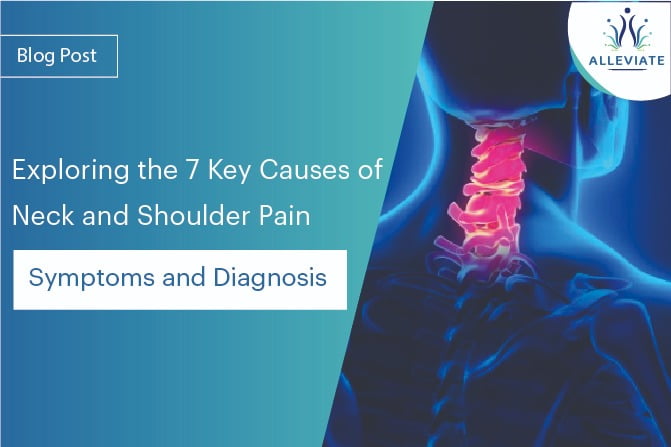Introduction
Neck and shoulder pain is a common issue that can disrupt daily activities and impact your overall quality of life. Understanding the underlying causes of this pain is essential for effective treatment and management. In this comprehensive blog, we will delve into seven prominent causes of neck pain and shoulder pain, correlating the symptoms and diagnosis of each condition. From cervical radiculopathy to muscular strains, we will provide insights backed by references from published articles and medical journals.
- Cervical Radiculopathy
Cervical radiculopathy occurs when a nerve root in the cervical spine becomes compressed or irritated. This condition can result from various factors, such as herniated discs or bone spurs. Common symptoms include radiating pain, numbness, tingling, and weakness that often follows a specific nerve pathway. Diagnosis involves a thorough clinical assessment, imaging studies, and possibly electromyography (EMG) to evaluate nerve function. - Cervical Disc Degenerative Disease / Cervical Spondylosis
Cervical disc degenerative disease, also known as cervical spondylosis, involves the gradual breakdown of discs and joints in the cervical spine. Symptoms include neck pain, stiffness, and possible radiating pain into the shoulders and arms. Diagnosis typically involves imaging studies like X-rays or MRI scans to assess the extent of degeneration and nerve compression. - Cervical Whiplash Injury
Whiplash injuries, often caused by sudden jerking of the head during accidents, can lead to neck and shoulder pain. Symptoms include neck stiffness, pain, headaches, and limited range of motion. Diagnosis may involve a detailed medical history, physical examination, and imaging studies to rule out other potential causes. - Trigger Points
Trigger points are hyperirritable knots in muscles that can refer pain to other areas, including the neck and shoulders. Symptoms include localized pain and tenderness that may radiate to nearby areas. Diagnosis involves a physical examination to locate trigger points and rule out other potential sources of pain. - Muscular Strains and Sprains
Overuse or sudden movements can cause strains or sprains in the neck and shoulder muscles. Symptoms include localized pain, muscle stiffness, and limited mobility. Diagnosis is often based on the patient’s medical history, physical examination, and ruling out other conditions through imaging studies. - Cervical Facet Joint Pain
Cervical facet joints are small joints located between the vertebrae in the neck. When these joints become inflamed or irritated, they can cause neck and shoulder pain. Symptoms include localized pain that can worsen with movement. Diagnosis involves physical examination, diagnostic injections, and imaging studies to confirm facet joint involvement. - Cervical Myofascial Pain Syndrome
Cervical myofascial pain syndrome involves muscle pain and discomfort due to trigger points or muscle tension. Symptoms include localized pain, muscle knots, and restricted range of motion. Diagnosis is made through physical examination and assessing trigger point presence.
Conclusion: Decoding the Complexity of Neck and Shoulder Pain
Neck and shoulder pain can stem from a variety of causes, each with its own unique symptoms and diagnostic approach. By understanding the intricacies of conditions like cervical radiculopathy, disc degenerative disease, whiplash injuries, trigger points, muscular strains, and facet joint pain, individuals can seek timely medical attention and appropriate treatment. A thorough evaluation by a healthcare professional, including imaging studies and clinical assessments, is crucial to pinpoint the exact cause and develop an effective treatment plan tailored to the individual’s needs.
References
- Magnus W, Viswanath O, Viswanathan VK, et al. Cervical Radiculopathy. [Updated 2023 Jul 10]. In: StatPearls [Internet]. Treasure Island (FL): StatPearls Publishing; 2023 Jan-. Available from: https://www.ncbi.nlm.nih.gov/books/NBK441828/
- Fakhoury J, Dowling TJ. Cervical Degenerative Disc Disease. [Updated 2023 Aug 14]. In: StatPearls [Internet]. Treasure Island (FL): StatPearls Publishing; 2023 Jan-. Available from: https://www.ncbi.nlm.nih.gov/books/NBK560772/
- James M. Elliott, PT, PhD1, Jon Timothy Noteboom, PT, PhD2, Timothy W. Flynn, PT, PhD3, Michele Sterling, PT, PhD4
Journal of Orthopaedic & Sports Physical Therapy
Published Online:May 1, 2009Volume39Issue5Pages312-323
https://www.jospt.org/doi/10.2519/jospt.2009.2826 - Bron C, Dommerholt JD. Etiology of myofascial trigger points. Curr Pain Headache Rep. 2012 Oct;16(5):439-44. doi: 10.1007/s11916-012-0289-4. PMID: 22836591; PMCID: PMC3440564.
- Binder AI. Cervical spondylosis and neck pain. BMJ. 2007 Mar 10;334(7592):527-31. doi: 10.1136/bmj.39127.608299.80. PMID: 17347239; PMCID: PMC1819511.
- Gellhorn AC, Katz JN, Suri P. Osteoarthritis of the spine: the facet joints. Nat Rev Rheumatol. 2013 Apr;9(4):216-24. doi: 10.1038/nrrheum.2012.199. Epub 2012 Nov 13. PMID: 23147891; PMCID: PMC4012322.
- Touma J, May T, Isaacson AC. Cervical Myofascial Pain. [Updated 2023 Jul 3]. In: StatPearls [Internet]. Treasure Island (FL): StatPearls Publishing; 2023 Jan-. Available from: https://www.ncbi.nlm.nih.gov/books/NBK507825/



